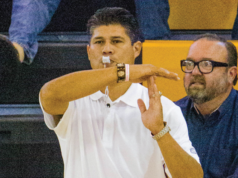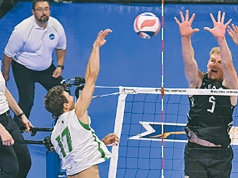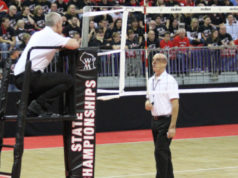Many volleyball referees work multiple sports. While it is difficult to keep all the rules straight from sport to sport, it is unlikely a softball umpire will accidentally call a strike in volleyball — and it is hoped few if any basketball referees have whistled volleyball players for double dribbling.
The greater challenge for volleyball referees is keeping the rule differences in mind when switching between NFHS, college and USAV rules. Most referees would admit there have been times when they momentarily forgot which version of a rule applied to a specific situation in the current match, and many have occasionally used the wrong signal when working a different rule set. This article will explore five of the most significant rule differences between the three rule sets.
1. How long is long enough?
The length of timeouts is one of the rules that is different for all three rule codes. In NFHS, timeouts are always 60 seconds in length. In USAV, timeouts are 30 seconds in length, every time. NCAA has a flexible rule regarding timeouts. The default length is 75 seconds. However, if both coaches agree, the length can be adjusted to 60 or 90 seconds.
In NFHS and NCAA, the second referee blows a warning whistle with 15 seconds remaining in the timeout, and the timeout may end early if both teams are ready to play. In USAV, there is no warning whistle, and the timeout cannot end early.
2. For the set or for the match?
Depending on the rules set in use, certain sanctions and situations apply either to the current set only, or carryover from set to set.
For example, in NCAA, delay sanctions and individual sanctions apply only to the current set, and are not carried forward to subsequent sets. That means the same team can get a delay warning (team yellow card) in every set. Only a second delay in the same set will progress to a delay penalty (red card). The same is true for individual sanctions — a team member can be sanctioned with a yellow card in each set. However, a caveat for individual sanctions is the referees are never required to warn before penalizing for unsporting behavior; significant misconduct can result in a penalty (individual red card), without warning. In addition to delay and individual sanctions, exceptional substitutions and libero redesignations are only for the current set. A player replaced by an exceptional substitution or a redesignated libero may return in a subsequent set.
The rules for those situations in NFHS resemble the NCAA rules. Team delays (unnecessary delays) do not carry over from set to set, and a player replaced by an exceptional substitution or a redesignated libero may return in a subsequent set. The only situation that is handled differently in NFHS relates to individual situations. Cards issued for unsporting conduct carry over from set to set throughout the match. A player or coach may only receive one yellow card warning in each match. A second act of misconduct by the same player or coach will result in a red card penalty. Also, in NFHS rules, if a yellow card for unsporting conduct is issued to the head coach, assistant coaches, or team bench, the head coach loses the privilege to stand and must remain seated for the remainder of the match.
The rules for USA Volleyball are completely different. All of the above situations are applied for the entire match. A team may only receive one delay warning (team yellow card) per match. Any subsequent delay in the same match will result in a delay penalty (team red card). The rule for individual sanctions is even more strict: A team may only receive one individual warning (yellow card) per set regardless of which team member is warned. Any subsequent misconduct by any team member will result in an individual penalty (red card). Exceptional substitutions and libero redesignations are also for the match. A player replaced by an exceptional substitution or a redesignated libero may not return to the match.
3. How many liberos?
In NFHS and NCAA rules, a team may designate one (or no) liberos per set. A different player may be designated as libero for each set, or a team can choose not to use a libero for any set. Additionally, if a player is designated as a libero for one set, he or she may change into a regular jersey and play as a regular player in any other set of the match.
The libero designation rules for USAV are a little more complicated. In a match played under USAV rules, a team is allowed to choose to designate two liberos, as long as it does so for the first set. Those two players are designated as liberos for the entire match. The team may not designate any other liberos for subsequent sets, and the two liberos may not play as regular players in the match (except as an exceptional substitution).
4. Who can stand?
In addition to keeping track of the players on the court, referees also have to pay attention to the players and coaches on the bench. In both USAV and NCAA, the substitutes can stand in the warmup area. In NFHS, substitutes must remain seated on the bench during play. The rules for which coaches can stand are different for all three rule sets. In NFHS, only the head coach may stand during play. In USAV, the head coach can always stand, and one assistant coach at a time may stand as well. In NCAA, any designated coach may stand at any time.
5. My side or your side?
Most of the rules related to playing a ball near the plane are the same for all three codes. In general, once the ball has entered the plane of the net, either team has equal right to play the ball. The only significant rule difference relates to the action of a player attempting to “save” a ball that is near the plane.
In NFHS and NCAA, a player may reach his or her hand(s) into the plane of the net to play the ball as long as some portion of the ball is still on that player’s side.
In USAV rules, a player may not reach beyond the plane of the net into the opponent’s space to play a ball, even if the ball is still partially (or completely) on that player’s side of the net. In USAV, it is the position of the player — not the position of the ball — that determines whether a fault has occurred.
This column covers a few of the most significant rule differences between the three rule sets. The Professional Association of Volleyball Officials (PAVO) compiles a comparison document each year that includes all of the important rule differences. That document can be accessed on the PAVO website at: pavo.org/Rules-and-Tools/Rule-Comparisons.
What's Your Call? Leave a Comment:
Note: This article is archival in nature. Rules, interpretations, mechanics, philosophies and other information may or may not be correct for the current year.
This article is the copyright of ©Referee Enterprises, Inc., and may not be republished in whole or in part online, in print or in any capacity without expressed written permission from Referee. The article is made available for educational use by individuals.


















